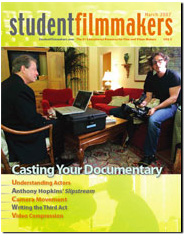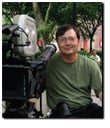Check out this
article in the print edition of StudentFilmmakers
Magazine, March 2007. More photos featured in the print
edition. Click
here to get a copy and to subscribe >>
 Notes
on Camera Movement Notes
on Camera Movement
When to Move the Camera and Why
by M. David Mullen, ASC
...
Continued from Previous Page
Besides the dramatic justification of a camera movement (to
heighten tension, move in tighter to see an emotional expression,
etc.) and the logical reasons (to follow important action in the
frame), there is a third, more technical use of camera movement,
which is to enhance the three-dimensional qualities of a two-dimensional
image. This can be in support of a story point � for example,
to establish that someone is hanging from a ledge or cliff top
with a long way to fall. Since true distances are hard to judge
in a 2D image, a slight camera movement (like craning out while
looking straight down) can create a perspective shift that makes
the actual distance more clear.
But the point of a movement may also simply be to make the shot
more immersive for the viewer, like in an action scene. It�s the
type of shot I like to say has a �Cinerama effect�. In the first
movie made in that special format, This is Cinerama, there was
a famous sequence where a camera moves up and down the tracks
of a rollercoaster, creating an immersive experience for the viewer.
The immense widescreen color image on a giant curved screen began
after a B&W prologue that only took up a small square in the center
of the screen; this transition made the effect more powerful.
Over the years, we have seen many variations of this Cinerama
effect; for example, the movie The Road Warrior (Mad Max 2) opens
with a B&W prologue but soon ends up on a low-angle, wide-angle
POV shot from a car racing down the highway. And like This is
Cinerama, the B&W image is square, but the color movie that follows
is very widescreen. But a much more subtle version of this same
�you are there� immersive effect is just when a camera with a
wide-angle lens glides through a room, especially when it passes
through constrictions like a small doorway before the space opens
up wider. These sorts of shots can be valuable in firmly placing
the viewer into the scene, rather than making them feel as if
they were observing the scene from a distance. Of course, the
larger the viewing image, assuming it has sufficient resolution
and clarity, the stronger the immersive effect, which is why so
many IMAX movies have the occasional super wide-angle moving shot,
like from a helicopter.
But you can apply this understanding to much more typical situations;
for example, a dolly into a close-up is more dimensional and dramatic
when the change in perspective is enhanced by using wider-angle
lenses. Conversely, a push-in on a long lens often does not feel
much more different than a zoom-in because of the lack of a perspective
shift as the camera moves (there are also the technical problems
of getting the dolly to move smoothly enough to not look bouncy
on a long lens, plus the difficultly in pulling focus). However,
most people avoid shooting close-ups with wide-angle lenses because
it can be distorting and unflattering. For this reason, medium
focal lengths are most commonly used for shots where the camera
dollies into a close-up, as a compromise between needing shorter
focal lengths to enhance the movement, but longer focal lengths
to be more flattering. Practically, this means when I�m shooting
in standard 35mm, for example, I might shoot a normal close-up
on a 75mm or 100mm lens, but if I have to dolly into a close-up,
I�m more likely to switch to a 40mm or 50mm. This is just a guideline,
of course � some directors love pushing in tight on a wide-angle
lens, despite or because of the distortion it creates.
A final note is if you want professional-looking camera moves
in your movie, hire a good dolly grip. That person will be a tremendous
aid in pulling off these types of shots.
Just remember that like any other cinematic technique, camera
movement is most effective when used with discretion � overuse
will cause the emotional effect to be lost, just as when you overuse
a close-up.
This article may not be reprinted in print
or internet publications without express permission of StudentFilmmakers.com.
Photos may not be copied or reproduced.
Check out this article in the March 2007
print edition of StudentFilmmakers magazine, pages
10-12. Click here to get a copy of the March 2007
Edition, so you can read and enjoy all of the excellent articles
inside.
About the Author:
 M.
David Mullen, ASC has earned two Independent Spirit Award nominations
for best cinematography, for Twin Falls Idaho in 1999 and for
Northfork in 2003, and has photographed over thirty films, including
The Astronaut Farmer (2007), Solstice (2006)
Akeelah and the Bee (2006), and Shadowboxer
(2005). M.
David Mullen, ASC has earned two Independent Spirit Award nominations
for best cinematography, for Twin Falls Idaho in 1999 and for
Northfork in 2003, and has photographed over thirty films, including
The Astronaut Farmer (2007), Solstice (2006)
Akeelah and the Bee (2006), and Shadowboxer
(2005).

Resources:
About
StudentFilmmakers Magazine & StudentFilmmakers.com
>>
Join
the Film and Digital Networking Community >>
Post
Your Films, Videos, Reels, and Trailers >>
Discuss
Motion Picture Techniques in the Online Industry Forums >>
Get
the StudentFilmmakers.com E-Newsletter >>
Subscribe
to the Magazine >>
StudentFilmmakers magazine would like to hear
from you!
Click here
to share your comments and feedback about the magazine,
monthly editions, your favorite articles, and your favorite topics.
We always welcome and appreciate your Reader Comments.
View them here, and send yours to the editorial
team today!
|

 M.
David Mullen, ASC has earned two Independent Spirit Award nominations
for best cinematography, for Twin Falls Idaho in 1999 and for
Northfork in 2003, and has photographed over thirty films, including
The Astronaut Farmer (2007), Solstice (2006)
Akeelah and the Bee (2006), and Shadowboxer
(2005).
M.
David Mullen, ASC has earned two Independent Spirit Award nominations
for best cinematography, for Twin Falls Idaho in 1999 and for
Northfork in 2003, and has photographed over thirty films, including
The Astronaut Farmer (2007), Solstice (2006)
Akeelah and the Bee (2006), and Shadowboxer
(2005).